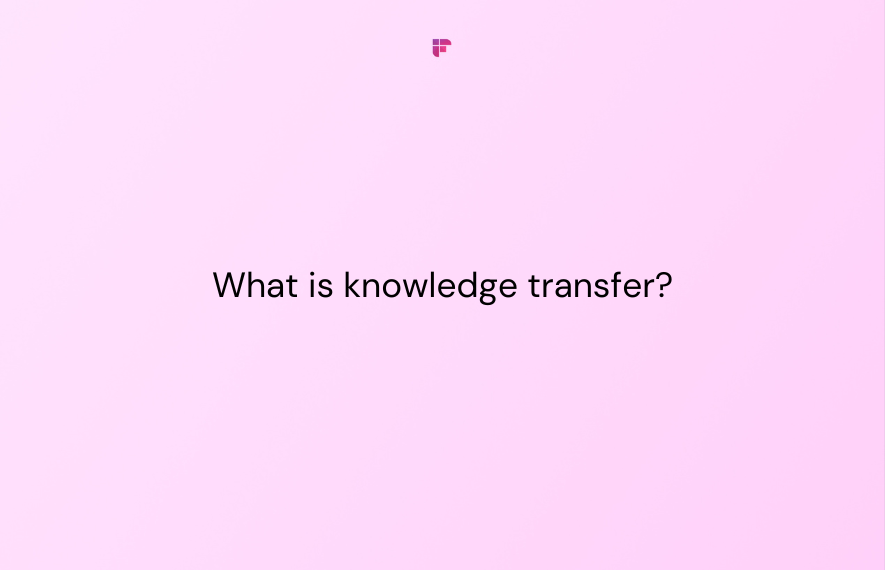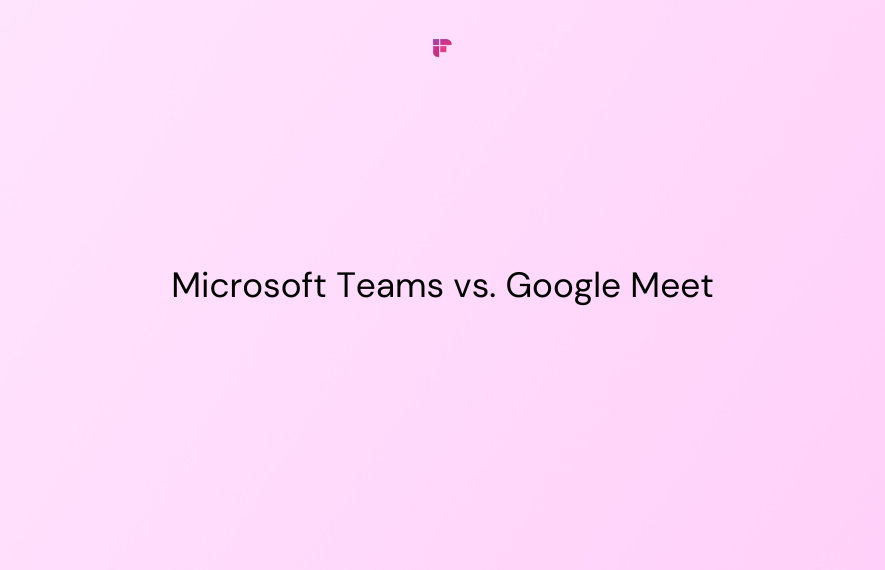Effective communication with your team is essential whether you're steering a large corporation or running a small business. As your organization expands with multiple departments, ensuring seamless information flow becomes even more critical. Miscommunications and organizational delays can be detrimental, leading to missed opportunities and operational hiccups. This is where knowledge transfer helps.
In this blog, we will simplify the concept of knowledge transfer, give a step-by-step guide on creating an effective knowledge transfer plan, and equip you with actionable insights and strategies for a seamless process.
What is knowledge transfer?

Knowledge transfer is the process of sharing information, skills, insights, or expertise from one individual, group, or organization to another. It involves successfully sharing and grasping information to improve someone's understanding, capabilities, and performance in a specific area.
Knowledge transfer bridges the gap between theory and practice. While formal education equips individuals with a foundational understanding, it is the transfer of tacit knowledge – the unwritten, experiential wisdom – that transforms novices into experts.
It connects experience with innovation, allowing organizations and individuals to evolve and adapt. Recognizing the importance of knowledge transfer is the first step toward building a culture of continuous learning and improvement.
Why does knowledge transfer matter?

Knowledge transfer plays a crucial role in shaping the trajectory of an organization due to several reasons:
- Preserving institutional memory: In businesses and organizations, institutional memory is the collective knowledge and experience that resides within a company. Imagine a key player leaving; without effective knowledge transfer, their valuable insights could walk out the door with them. A well-executed knowledge transfer plan ensures that institutional wisdom is preserved, maintaining business continuity.
- Fostering innovation: Knowledge transfer is the lifeblood of innovation. Organizations can build upon existing knowledge to drive creativity and develop groundbreaking solutions by facilitating the exchange of ideas and insights. It's the catalyst for staying ahead in today's rapidly evolving landscape.
- Empowering succession planning: Effective knowledge transfer is vital for succession planning. When seasoned professionals pass on their knowledge to successors, organizations can ensure a smooth transition in leadership, minimizing disruptions and maintaining operational excellence.
- Enhancing team collaboration: In collaborative settings, knowledge transfer promotes a culture of learning and collaboration. Teams that actively share knowledge can leverage diverse skills, leading to more efficient problem-solving and a more adaptable workforce.
- Risk mitigation: A comprehensive knowledge transfer plan minimizes the risk associated with losing key personnel or sudden changes in the organizational structure. It ensures that critical information is not concentrated in a few individuals.
Creating an effective knowledge transfer plan

Now that we've established the why, let’s dive into the how. Creating an effective knowledge transfer plan requires thoughtful consideration and a strategic approach.
1. Identify key knowledge holders
Start by identifying the individuals or teams holding the keys to essential knowledge. Who are the seasoned experts? What departments house critical information? These could be subject matter experts, long-term employees, or those with specialized skills. Knowing who holds key information is the first step in the transfer process.
2. Document tacit and explicit knowledge
Tacit knowledge, often gained through experience, can be challenging to articulate. Create a repository for such critical information. This could be in the form of manuals, guides, or digital documentation. Make sure this information is accessible and understandable to a diverse audience. Tools like wikis or knowledge management systems can be invaluable.
3. Champion mentorship programs
Mentorship is the human touch in knowledge transfer. Pair experienced employees with newer team members to facilitate the exchange of skills and insights. This fosters a collaborative environment and accelerates the learning curve for new employees.
4. Interactive training programs
Develop formal training programs that cover essential skills and knowledge. Make it interactive, engaging, and tailored to the needs of your audience. These can include workshops, seminars, and online courses designed to equip employees with the skills and insights necessary for their roles.
5. Leverage technology
Technology plays a crucial role in knowledge transfer. Implement knowledge management systems, collaborative platforms, and documentation tools to centralize information and make it easily accessible to all team members. Embrace tools that suit your organization's culture and needs.
6. Foster a culture of collaboration
Break down silos and foster a culture where collaboration is the norm. Encourage cross-functional projects, team-building activities, and open communication. The more freely information flows, the more successful your knowledge transfer initiatives will be.
7. Evaluate and adapt
A knowledge transfer plan is not a static document; it’s a living, breathing entity. Regularly evaluate its effectiveness. Seek feedback from those involved and make adjustments accordingly. Flexibility is key to long-term success.
Measuring success in knowledge transfer

To ensure the success of your knowledge transfer initiatives, involves some strategic measures like:
1. Establish Key Performance Indicators (KPIs)
Define clear KPIs to measure the success of your knowledge transfer initiatives. These could include reduced onboarding times, increased employee satisfaction, or measurable improvements in project outcomes.
2. Solicit feedback
Regularly seek feedback from both knowledge holders and recipients. Understand what's working well and where adjustments are needed to refine your knowledge transfer processes continually.
3. Monitor the application of transferred knowledge
Track how transferred knowledge is being applied in real-world scenarios. This not only validates the effectiveness of the knowledge transfer but also identifies areas for improvement.
Unlocking seamless knowledge transfer with Fireflies.ai

Meetings – the melting pot for ideas, decisions, and the occasional "Aha!" moment. But how often do those critical insights get lost in the shuffle of our daily tasks? Fear not, because Fireflies.ai is here to be your trusty virtual notebook, capturing every nuance of your meetings and transforming them into a neatly organized repository of information.
The virtual notebook experience
Fireflies is not just your run-of-the-mill note-taking app; it's a powerhouse that effortlessly captures meeting minutes, key insights, and critical discussions. Imagine having a virtual scribe who diligently records every word, allowing you to be fully present in the moment without worrying about missing a beat.
Centralized repository for effortless access
What sets Fireflies apart is its ability to create a centralized repository of meeting records. No more digging through endless files or scrolling through chaotic notes – Fireflies organizes your information in three default channels and allows you to create unlimited channels based on your subscription. It's like having a neatly indexed library of your team's collective knowledge at your fingertips.
Quickly retrieve information
Fireflies.ai offers different search options that make information retrieval hassle-free. You can use the search bar at the top of the Fireflies Notebook to search across meetings or navigate to a meeting and use Smart Search filters to review that particular meeting. Another quick way to search for information is by using AskFred. This GPT-4-powered chatbot can answer meeting-related questions and even draft content like follow-up emails, social media posts, quotes, etc.
Offline knowledge transfer
Fireflies takes it a step further with its mobile app, addressing knowledge transfer challenges in offline scenarios. Imagine you're on a flight, brainstorming with a colleague, and bam – Fireflies captures every word. The mobile app records offline conversations and transcribes them, ensuring that knowledge transfer is still in full swing even when the Wi-Fi is nowhere to be found. And for those moments when connectivity is available, Fireflies on the Web performs the same magic for online knowledge transfer.
Conclusion
So, there you have it – knowledge transfer decoded! It's not just corporate jargon; it's the lifeblood that keeps organizations thriving. By understanding its essence, recognizing its importance, and implementing a well-crafted knowledge transfer plan, individuals and organizations can harness the power of shared insights for continuous growth and success. Knowledge transfer is not just a process; it's an investment in the future, ensuring that the wisdom accumulated today propels us further tomorrow. With this guide in hand, you won't just be transferring knowledge; you'll be empowering a culture of learning and growth.
💡 Making knowledge transfer seamless with Fireflies.ai
Fireflies is your virtual meeting companion that not only captures key insights but also organizes them into a digital treasure trove for effortless knowledge transfer.






